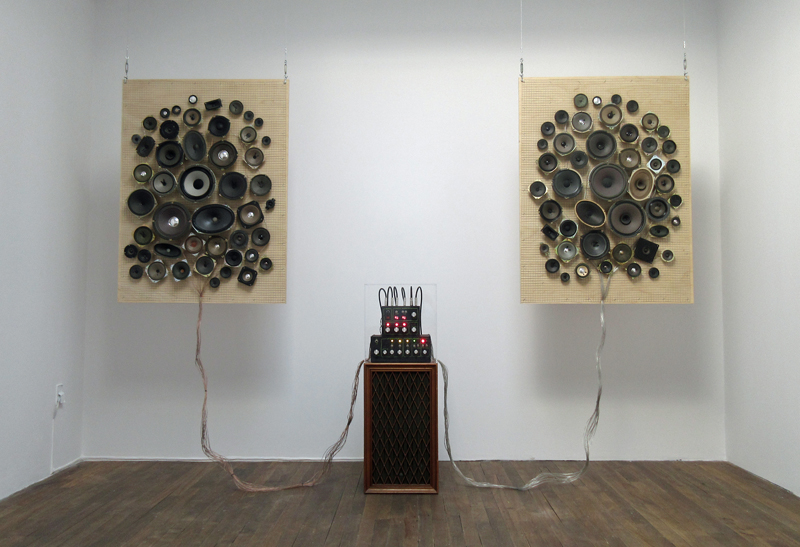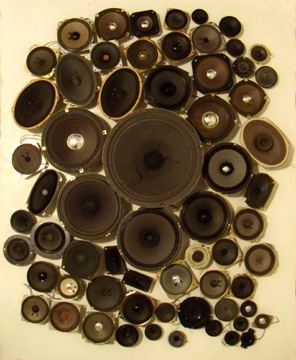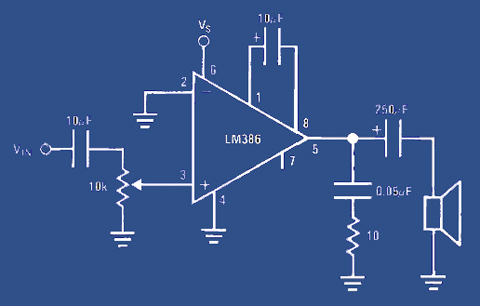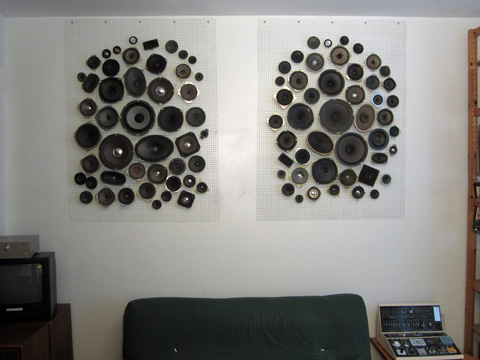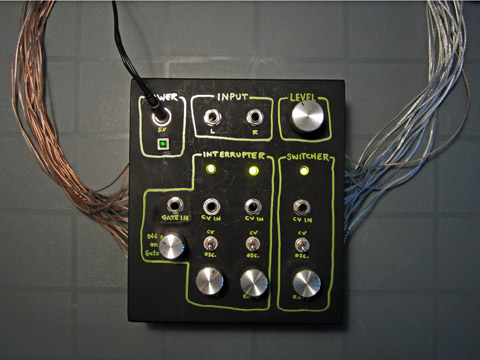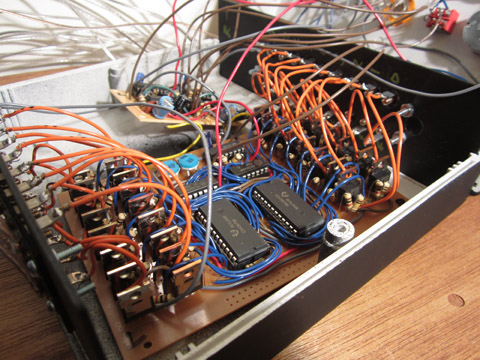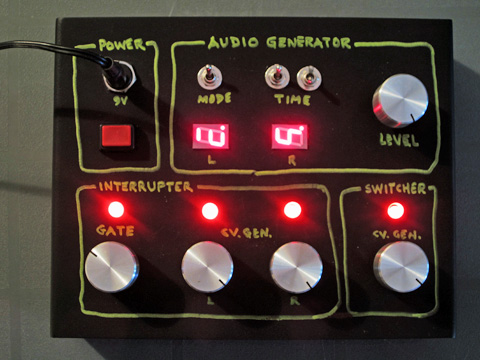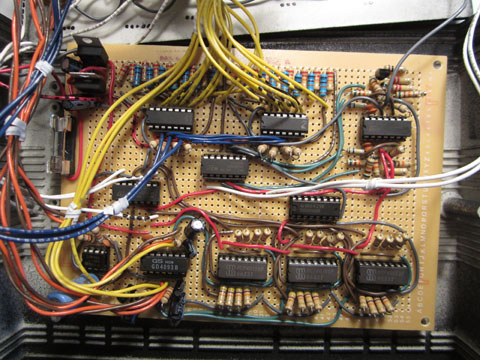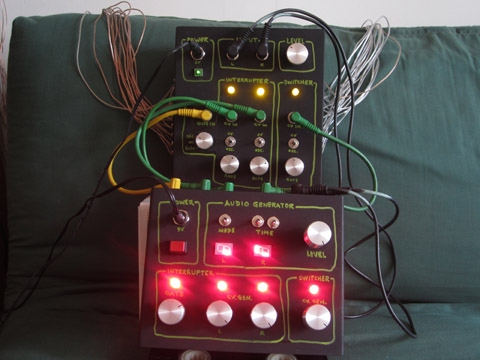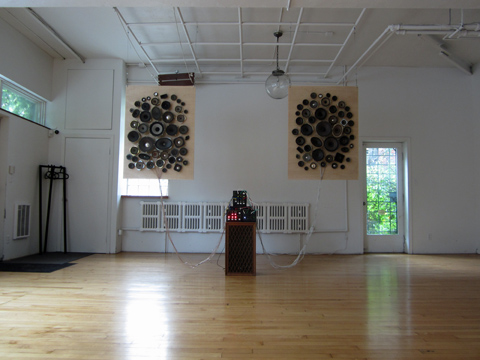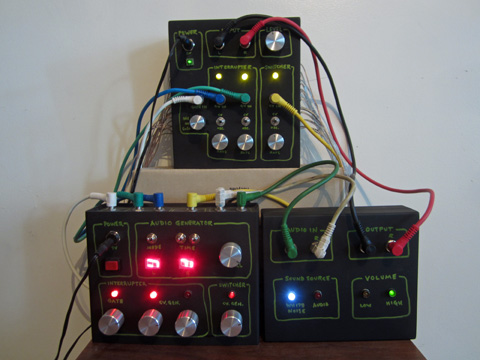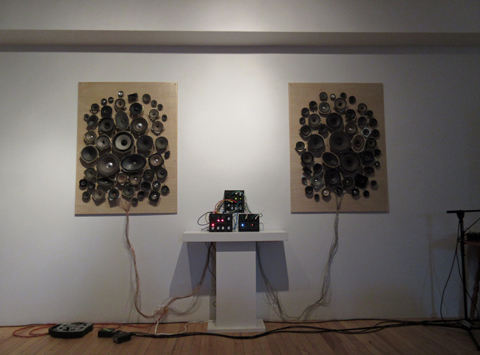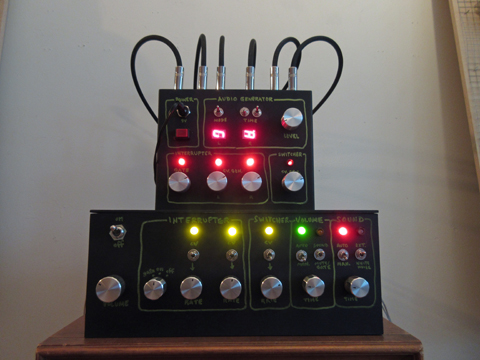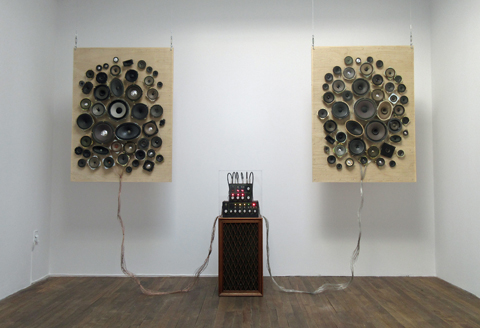The Sweet32 Speaker Interrupter-Switcher Installation Thing
(Ceci n'est pas la haute-fidélité)
by James Schidlowsky
A lo-fi recycled speaker installation that spatialises and changes the perception of sound. It can be used in either a standalone sound
installation mode or a performative mode.
After a few years of collecting speakers from stuff found in the trash, I finally got them off the floor and onto the wall.
The starting point of this sound installation is that every speaker has its unique timbre. Thus the same sound
can be perceived differently depending on which one is playing the sound. Three electronic circuit boxes make the
speakers emit sounds in an intermittent and random manner. Due to the placement of the speakers as well as
imperfections in the electronic switching and amplification, the result is a bizarre lo-fi spatialisation.
Most photos can be clicked on to view a larger version...
2008: The Collection Begins...
I started seriously collecting interesting speakers from the garbage, with vague ideas of what to do with them when I had
amassed "enough" of them. By November, they numbered about 65, and I took this photo.
Since at that point, I didn't know much about electronics, I had talked to some friends who did, and was told that my ideas
wouldn't work, or would be very complicated to implement.
In the next year or two, the collection grew to over 100 speakers and I pretty much stopped, unless I came across
a really interesting one.
2010: Learning Electronics
I started to learn about electronics, building various handmade electronic sound boxes,
experimenting with certain things that would eventually be useful for this project.
Meanwhile, the speaker collection sat on the floor, under a plastic dropsheet.
August 2012. Phase 1: Wall Decoration
To coincide with the squintfuckerpress
launch event at my place, I decided to finally get the speakers off the floor and onto the wall.
By this time I figured out that the easiest way to do that was to attach
them to rabbit fence grill with wire. It was a lot of work. In the end, by complete coincidence,
there were 47 speakers per grill.
December 2012. Phase 2: Wiring and Control Electronics
Since it was not practical to wire up every single speaker, I wired up 16 per board. This makes 32 speakers in all,
and is where I got the "Sweet32" part of the project's title... a little joke reference to the "Sweet 16" speaker
array system from the
January 1961 Popular Electronics
magazine.
I devised a control box which would randomly select which speaker was active per grill at any one time.
To make things fun, I also made a circuit which would interrupt the signal on each channel separately.
The rate of these actions could be controlled by the knobs.
To make things even more fun, I put CV (Control Voltage) inputs on those, so that the knobs could be bypassed and controlled by external signals.
The thing was finally able to be shown to people, private-viewing style, at my place.
Inside the Control Box
For the technically-minded: since the CMOS CD4067 multiplexers could not handle the current required to drive the speakers, I used MOSFET transistors to do the actual switching... 32 of them!
May 2013. Phase 3: Automator Electronics
After much research and many experiments, I finally arrived at the circuits I wanted for the control box automator. The idea was to create a box that would interface the speaker control box shown above, and would slowly change parameters. This way, it could truly be a standalone installation, ever-changing and not requiring human intervention except to power on the boxes.
Thus the box generates triangle wave tones separately for both channels, either randomly, or by rising and falling slowly in pitch. It can generate 256 different tones, which are represented by the sideways LED displays.
It also generates the CV and gate signals to control the rate of the interrupters and switcher.
Inside the Automator Box
11 chips, including two PICAXE-14M2 microcontrollers, lots of wires. I'm trying to get more organized and do nicer, cleaner layouts, learning each time I build a box.
The Automator Box Controlling the Control Box
No, there won't be a control box for the control box which controls the control box!
August 2014: Phase 4: Extramural Exhibition and Concert
The installation was exhibited for several days at the STABLE gallery/space in Montreal. The speaker
grills were mounted on Baltic birch plywood boards and suspended from the ceiling using aircraft cable.
For the closing day, there were two concert sets featuring pieces composed and performed for the speaker system by
Alexandre St-Onge and
Alexander MacSween.
August 2014: Three Control Boxes for Installation Mode
I decided that white noise was also an interesting thing, as well as different volumes. So for the gallery installation,
I built the simple "Sound Source/Volume Control Box" (lower right in photo) that alternates between white noise and the frequencies produced by the Automator. It also randomly decides which of 3
volume levels to use: maximum, medium and almost-silent. The rates of these are independent.
May 2016: New Control Box
This control box replaces the original one, featuring slightly improved amplification and incorporating the functions of the
"source and volume switcher" box that was built in August 2014. An additional feature is that it can use a gate signal that will silence
the audio, for example, one could use a sensor so that the installation only produces sound when someone is present in the room.
June 2016: Exhibition at OBORO
The installation was exhibited for two weeks at the OBORO gallery in Montreal, from
June 4-18, 2016.
Click through for details, photos and opuscule.
Upcoming related events...
- Nothing for the moment. Slowly collecting speakers for a possible more organic version.
